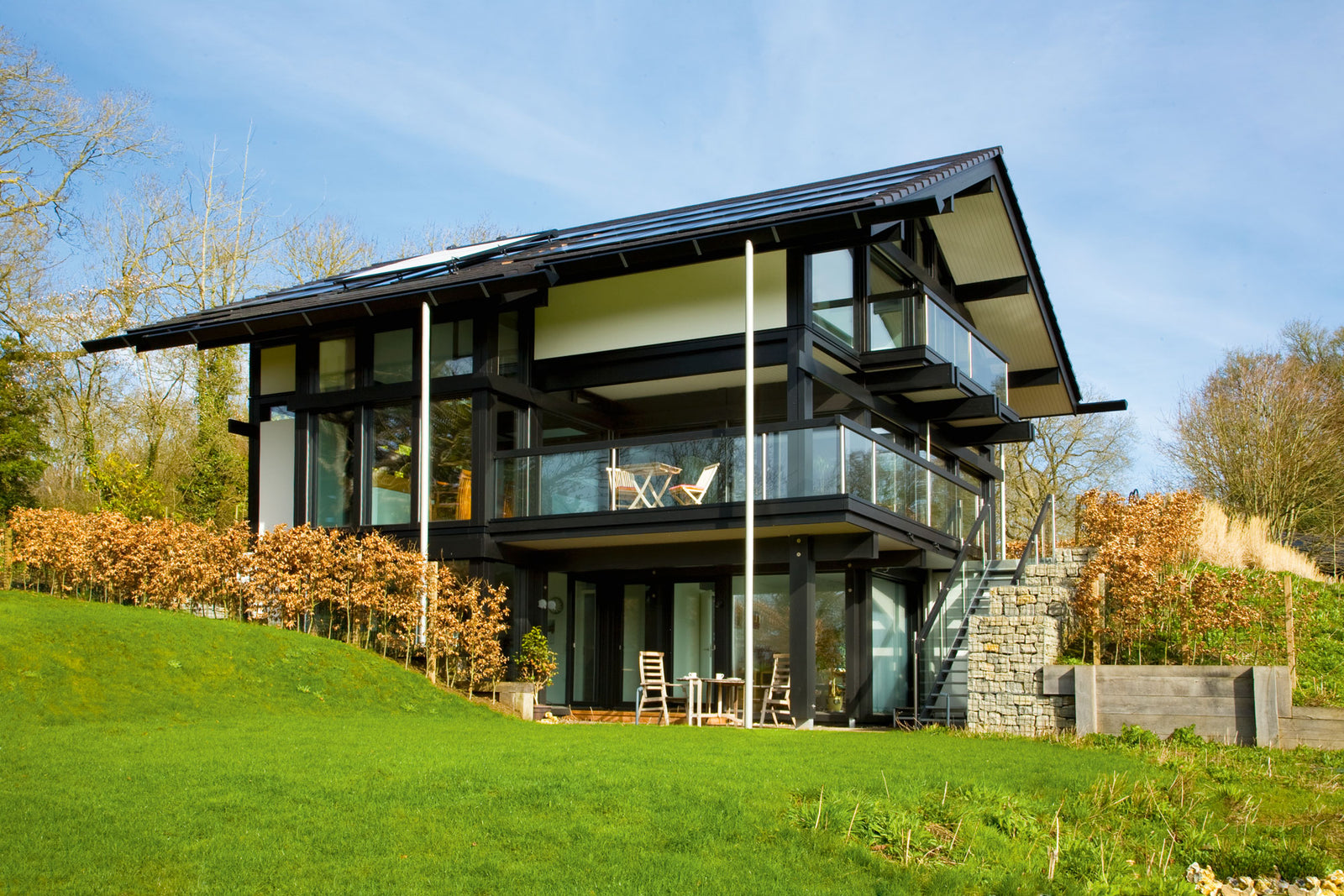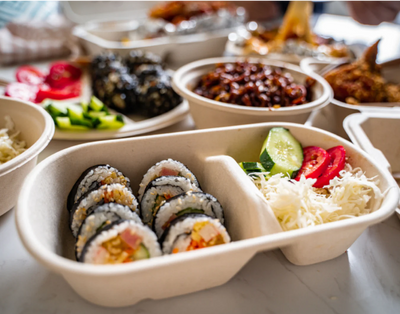Trái đất đang nóng dần lên, ô nhiễm môi trường ngày càng gia tăng, con người đang phải đối mặt với nhiều vấn đề về sức khỏe và tài nguyên thiên nhiên. Trong bối cảnh đó, ngôi nhà sinh thái đang dần trở thành xu hướng mới, được nhiều người quan tâm và lựa chọn.
Vậy ngôi nhà sinh thái là gì? Lợi ích của ngôi nhà sinh thái ra sao? Các hình thức ngôi nhà sinh thái phổ biến? Hãy cùng EQUO tìm hiểu nhé!
1. Ngôi nhà sinh thái là gì?
Ngôi nhà sinh thái là một mô hình nhà ở ít tác động đến môi trường, được thiết kế và xây dựng bằng vật liệu và công nghệ giúp giảm lượng khí thải carbon và giảm tiêu thụ năng lượng. Nhà sinh thái được thiết kế theo nhiều cách đáp ứng nhu cầu bền vững như tiết kiệm nước, giảm chất thải thông qua tái sử dụng và tái chế vật liệu, kiểm soát ô nhiễm để hạn chế sự nóng lên toàn cầu, sản xuất và tiết kiệm năng lượng cũng như giảm lượng khí thải CO2.

Nguồn: Internet
>> Xem thêm:
- Ống Hút Bã Cà Phê EQUO Tự Phân Hủy, Dùng Được Cho Đồ Uống Nóng
- Ống Hút Gạo Ăn Được EQUO: Sản Phẩm Không Nhựa Bảo Vệ Môi Trường
- 20+ Ý Tưởng Tái Chế Ống Hút Nhựa: Đơn Giản Và Dễ Làm
- Shark Tank Ống Hút Cỏ - Dự Án Startup Thành Công Mang Tên EQUO
- Bã Mía Dùng Để Làm Gì? Những Công Dụng Đặc Biệt Từ Bã Mía
2. Đặc điểm của ngôi nhà sinh thái
Trong thời đại hiện nay, ngôi nhà sinh thái đang trở thành một xu hướng phổ biến không chỉ vì sự bảo vệ môi trường mà còn vì lợi ích kinh tế và sức khỏe mà nó mang lại. Dưới đây là những đặc điểm chính của ngôi nhà sinh thái:
2.1. Vật liệu xây dựng
Ngôi nhà sinh thái thường được xây dựng từ các vật liệu tái chế hoặc vật liệu tự nhiên như gỗ, đá, đất sét, bê tông tái chế, cát tái chế và nhiều vật liệu khác. Sử dụng vật liệu này không chỉ giúp giảm lượng rác thải trong môi trường mà còn giúp giảm thiểu tác động của ngôi nhà đối với môi trường.

Nguồn: Internet
2.2. Hiệu quả năng lượng
Một trong những đặc điểm quan trọng của ngôi nhà sinh thái là hiệu quả năng lượng. Chúng thường được thiết kế với hệ thống cách nhiệt tốt, sử dụng ánh sáng tự nhiên và hệ thống điện mặt trời để tối ưu hóa việc sử dụng năng lượng. Ngoài ra, các thiết bị tiết kiệm năng lượng như đèn LED, máy lạnh, máy sưởi, cũng được tích hợp vào ngôi nhà để giảm thiểu lượng điện tiêu thụ.

Nguồn: Internet
2.3. Tiết kiệm nước
Ngôi nhà sinh thái không chỉ sử dụng các vật liệu thân thiện với môi trường mà còn chú trọng vào việc tiết kiệm nước. Các thiết bị tiết kiệm nước như vòi sen, toilet xả tiết kiệm nước được sử dụng phổ biến. Hệ thống thu thập và tái sử dụng nước mưa cũng được lắp đặt để tưới cây và vườn. Nhờ vậy, lượng nước sử dụng hàng ngày được giảm thiểu đáng kể, góp phần bảo vệ nguồn nước và duy trì sự bền vững cho môi trường.

Nguồn: Internet
2.4. Giảm thiểu rác thải
Ngôi nhà sinh thái không chỉ chú trọng vào việc sử dụng năng lượng hiệu quả và tiết kiệm nước mà còn hướng đến mục tiêu giảm thiểu rác thải. Để đạt được mục tiêu này, người ta thường sử dụng các sản phẩm tái chế, tái sử dụng và hạn chế tối đa việc sử dụng các vật liệu gây ô nhiễm môi trường. Nhờ vậy, nhà sinh thái không chỉ mang đến môi trường sống bền vững mà còn góp phần bảo vệ môi trường toàn cầu.

Nguồn: Internet
Trong bối cảnh ngày nay, việc xây dựng và sử dụng ngôi nhà sinh thái không chỉ là một xu hướng mà còn là một sự cần thiết. Không chỉ đơn thuần là một nơi ở, ngôi nhà sinh thái đại diện cho một lối sống bền vững và có trách nhiệm với môi trường.
3. Lợi ích của ngôi nhà sinh thái
Khi chọn lựa xây dựng một ngôi nhà sinh thái, bạn không chỉ đang đóng góp vào việc bảo vệ môi trường mà còn có thể hưởng một loạt các lợi ích kinh tế và sức khỏe cá nhân. Dưới đây là những lợi ích quan trọng của ngôi nhà sinh thái:
3.1. Tiết kiệm chi phí
Mặc dù có thể tạo ra một chi phí ban đầu cao hơn so với việc xây dựng một ngôi nhà thông thường, nhưng ngôi nhà sinh thái sẽ giúp bạn tiết kiệm rất nhiều chi phí trong dài hạn. Với hệ thống tiết kiệm năng lượng, bạn có thể giảm thiểu hóa đơn tiền điện hàng tháng. Sử dụng thiết bị tiết kiệm nước cũng giúp giảm chi phí tiền nước. Hơn nữa, vật liệu xây dựng bền vững và tái chế giúp giảm chi phí bảo trì và sửa chữa trong tương lai.

Nguồn: Internet
3.2. Nâng cao sức khỏe
Ngôi nhà sinh thái thường được thiết kế để tối ưu hóa sự thoáng đãng và ánh sáng tự nhiên, cũng như giảm thiểu sự sử dụng các chất độc hại trong vật liệu xây dựng, tạo điều kiện sống lý tưởng, giúp cải thiện chất lượng không khí bên trong nhà và giảm nguy cơ các vấn đề sức khỏe như dị ứng và các bệnh đường hô hấp.

Nguồn: Internet
3.3. Bảo vệ môi trường
Lợi ích lớn nhất của việc sở hữu một ngôi nhà sinh thái là sự đóng góp vào việc bảo vệ môi trường. Việc sử dụng vật liệu xây dựng bền vững, tiết kiệm năng lượng và nước, cùng việc giảm thiểu rác thải đều giúp giảm lượng khí thải và tác động tiêu cực đến môi trường tự nhiên. Điều này góp phần vào việc bảo vệ nguồn tài nguyên và giữ cho hành tinh chúng ta xanh sạch hơn cho các thế hệ tương lai.

Nguồn: Internet
Như vậy, ngôi nhà sinh thái không chỉ là một nơi ở, mà còn là biểu tượng của một cách sống hiểu biết và trách nhiệm. Khi lựa chọn xây dựng một ngôi nhà sinh thái, bạn không chỉ làm phong phú hơn cho cuộc sống của mình mà còn góp phần vào việc bảo vệ môi trường và tương lai của hành tinh. Hãy cùng chung tay xây dựng một tương lai bền vững hơn bằng cách lựa chọn ngôi nhà sinh thái cho gia đình bạn!
4. Các hình thức ngôi nhà sinh thái phổ biến
Khi nói đến ngôi nhà sinh thái, có nhiều phong cách và hình thức khác nhau được phát triển để đáp ứng nhu cầu của các gia đình và cá nhân muốn sống bền vững và thân thiện với môi trường. Dưới đây là một số hình thức ngôi nhà sinh thái phổ biến:
4.1. Passive homes
Những ngôi nhà này được thiết kế để tận dụng một cách tối đa năng lượng tự nhiên từ ánh sáng mặt trời và nhiệt độ của môi trường. Các hệ thống cách nhiệt và cách âm được tích hợp để giữ cho ngôi nhà ấm vào mùa đông và mát vào mùa hè mà không cần sử dụng nhiều năng lượng.

Nguồn: Internet
4.2. Zero carbon homes
Đây là loại ngôi nhà mà hoạt động hàng ngày không gây ra khí thải carbon hoặc có khí thải carbon rất thấp. Điều này thường được đạt được thông qua việc sử dụng nguồn năng lượng tái tạo như điện mặt trời hoặc gió, cùng với việc sử dụng vật liệu xây dựng thân thiện với môi trường.

Nguồn: Internet
4.3. Earthships
Earthships là loại ngôi nhà được xây dựng từ các vật liệu tự nhiên như gạch đất, đất sét và vật liệu tái chế như lốp xe cũ. Chúng thường có hình dạng không gian sống sáng tạo và sử dụng các hệ thống thu thập nước mưa và năng lượng mặt trời.

Nguồn: Internet
4.4. Straw bale homes
Ngôi nhà này được xây dựng từ cỏ lúa mạch bao bọc trong lớp vật liệu cách nhiệt. Vật liệu này không chỉ là nguồn tái tạo mà còn có khả năng cách nhiệt tốt, giúp giữ cho ngôi nhà ấm vào mùa đông và mát vào mùa hè.

Nguồn: Internet
4.5. Rammed Earth
Rammed Earth là một phương pháp xây dựng truyền thống sử dụng đất và sỏi nén chặt lại để tạo ra các tấm tường. Đây là một phương pháp xây dựng bền vững với ít khí thải carbon và một lớp cách nhiệt tự nhiên.

Nguồn: Internet
4.6. Prefabs
Prefab là viết tắt của "pre-fabricated", có nghĩa là các phần của ngôi nhà được chế tạo sẵn trong một nhà máy và sau đó được lắp ráp tại công trình xây dựng. Các ngôi nhà prefab thường được thiết kế để tiết kiệm năng lượng và dễ dàng lắp ráp.

Nguồn: Internet
4.7. Tiny homes
Tiny homes là các ngôi nhà nhỏ gọn, thiết kế để tối ưu hóa không gian và tối thiểu hóa lượng tài nguyên cần thiết cho mỗi người. Các tiny homes thường sử dụng năng lượng tái tạo và có thể di chuyển để giảm thiểu tác động đến môi trường.

Nguồn: Internet
Với những lựa chọn đa dạng như vậy, việc chọn lựa một ngôi nhà sinh thái phù hợp với nhu cầu và phong cách sống của bạn không chỉ mang lại một không gian sống bền vững mà còn là một đóng góp ý nghĩa vào việc bảo vệ môi trường và tương lai của hành tinh chúng ta.
Chung tay cùng EQUO - Thương hiệu bền vững cho một cuộc sống xanh
EQUO là thương hiệu Việt Nam tiên phong trong lĩnh vực sản xuất và cung cấp các sản phẩm thay thế cho nhựa dùng một lần. Với sứ mệnh "Chung tay bảo vệ môi trường, hướng đến cuộc sống xanh", EQUO cam kết mang đến cho khách hàng những sản phẩm chất lượng cao, thân thiện với môi trường và giá cả hợp lý.
Các sản phẩm của EQUO được làm từ nguồn nguyên liệu tự nhiên 100%, không chứa nhựa và có thể tự phân huỷ trong vòng 3-6 tháng:
- Bộ ống hút thiên nhiên tự phân huỷ: Được làm từ cà phê, bã mía, dừa, cỏ bàng và gạo, an toàn cho sức khỏe, tự phân hủy hoàn toàn trong môi trường tự nhiên.
- Hộp đựng thực phẩm: Được làm từ bã mía, là một nguồn nguyên liệu tự nhiên bền vững có thể tái tạo và phân huỷ một cách nhanh chóng. Đặc điểm nổi bật của sợi bã mía nằm ở tính chất bền chắc, linh hoạt trong khả năng đóng gói, và chất lượng thoáng khí, không thấm nước.
- Bộ dao, muỗng, nĩa: Đây là một lựa chọn tuyệt vời cho những ai đang tìm kiếm một bộ đồ ăn thân thiện với môi trường và bền đẹp.
- Bộ ly giấy với công nghệ tráng nước: Sử dụng công nghệ tráng nước, không tráng nhựa (PP, PE hoặc PLA) giúp quá trình sản xuất ít thải ra khí carbon và khi phân hủy không để lại các tác động xấu đến môi trường như ly giấy thông thường. Phân hủy hoàn toàn trong môi trường tự nhiên trong vòng 18 tuần, đa dạng kích thước, phù hợp cho nhiều mục đích sử dụng.
Hãy cùng EQUO chung tay sử dụng các sản phẩm thân thiện với môi trường, để biết thêm thông tin về các dòng sản phẩm EQUO, mời bạn truy cập link sau:
>> https://shopequo.com/vi/collections

Ngôi nhà sinh thái không chỉ mang lại cho bạn một môi trường sống thân thiện với môi trường, tiết kiệm chi phí mà còn góp phần bảo vệ môi trường chung của cộng đồng. Đó không chỉ là nơi ở mà còn là biểu tượng cho một lối sống thông minh, tiết kiệm và có trách nhiệm với hành tinh chúng ta. Vậy hãy cùng EQUO hành động, từ việc chọn lựa vật liệu xây dựng đến việc sử dụng năng lượng tái tạo và tiết kiệm tài nguyên mỗi ngày, để chúng ta có thể xây dựng những tổ ấm xanh - nơi mà không chỉ là nơi ở mà còn là nguồn cảm hứng cho một cuộc sống đầy ý nghĩa và trách nhiệm. Hãy bắt đầu hành trình của bạn với ngôi nhà sinh thái và hòa mình vào cơn sóng xanh của tương lai!







3 comments
A well-articulated piece on ecological houses! The insights on sustainability and eco-friendly choices are truly inspiring. Thanks for sharing!
Great article on building an ecological house! The tips provided are insightful and encourage sustainable living. Thanks for sharing such valuable information!
Insightful read on ecological houses! This blog highlights how sustainability and comfort can go hand in hand. Great inspiration!